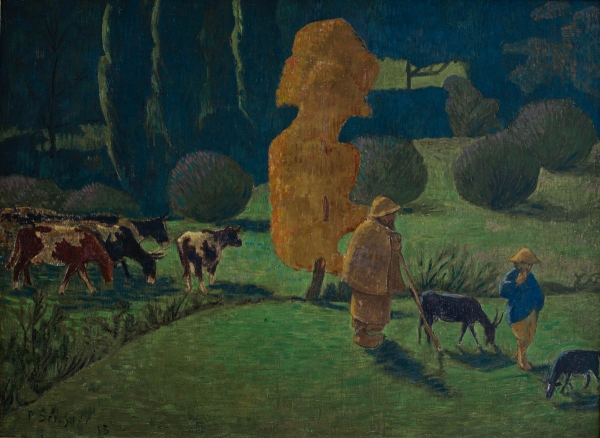Sérusier, The Shepherd Corydon

Paul SÉRUSIER (1864-1927)
The Shepherd Corydon
1913
oil on canvas
73 x 99 cm
© MuMa Le Havre / David Fogel
The Shepherd Corydon
1913
oil on canvas
73 x 99 cm
© MuMa Le Havre / David Fogel
HD image
podcast
In 1888, under Paul Gauguin's instruction, Paul Sérusier (1864–1927) produced The Talisman, the painting that led to the formation of the Nabis as an important example of the movement's aesthetic: simplified shapes, broad planes of pure colour, and a rejection of the codes of realism and perspective.
Sérusier was highly cultured, and thus able to approach mythological compositions with subtlety. With The Shepherd Corydon, he illustrated a scene from Virgil's Eclogues, a group of poems on the pleasures of pastoral life and the frustrated passion of the Corydon shepherd for a young boy, Alexis, who serves another master.
The artist transposes the episode to the countryside in Brittany, his adoptive land. Sérusier takes a few liberties with the verdant landscape, such as adding cows, which are not found in Virgil's poem. The scene is composed of simple masses that give it rhythm: the rigid human figures, a stylized central tree, the vertical lines of the poplars contrasting with the spherical bushes. The strange silhouette of the rust-coloured tree, a focal point of the composition, remains open to many interpretations (the personification of the Greek god Pan, in particular). The palette of colours is limited to three: the blue of Alexis' overcoat, the gradations of green punctuated by the pink dabs of the pastures and poplars, and the orange of the central tree.
True to Virgil's text, Sérusier depicts Alexis' disdain for the shepherd (he turns his back and seems to distance himself from him), but emphasizes the crude, rustic nature of the scene. Nicknamed the "nabi à la barbe rutilante" for his brilliant beard, Sérusier is thought to have portrayed himself in the shepherd's features. Although he is telling of unhappy love, the painter is more interested here in conveying the recollection and serenity of the landscape according to the ideal of harmony he strives to achieve in his painting.
Sérusier was highly cultured, and thus able to approach mythological compositions with subtlety. With The Shepherd Corydon, he illustrated a scene from Virgil's Eclogues, a group of poems on the pleasures of pastoral life and the frustrated passion of the Corydon shepherd for a young boy, Alexis, who serves another master.
The artist transposes the episode to the countryside in Brittany, his adoptive land. Sérusier takes a few liberties with the verdant landscape, such as adding cows, which are not found in Virgil's poem. The scene is composed of simple masses that give it rhythm: the rigid human figures, a stylized central tree, the vertical lines of the poplars contrasting with the spherical bushes. The strange silhouette of the rust-coloured tree, a focal point of the composition, remains open to many interpretations (the personification of the Greek god Pan, in particular). The palette of colours is limited to three: the blue of Alexis' overcoat, the gradations of green punctuated by the pink dabs of the pastures and poplars, and the orange of the central tree.
True to Virgil's text, Sérusier depicts Alexis' disdain for the shepherd (he turns his back and seems to distance himself from him), but emphasizes the crude, rustic nature of the scene. Nicknamed the "nabi à la barbe rutilante" for his brilliant beard, Sérusier is thought to have portrayed himself in the shepherd's features. Although he is telling of unhappy love, the painter is more interested here in conveying the recollection and serenity of the landscape according to the ideal of harmony he strives to achieve in his painting.
















